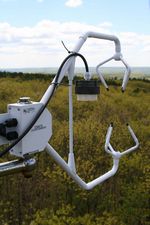You are here
New Funding for Global Change and Carbon Dynamics Research
The Terrestrial Carbon Program of the U.S. Department of Energy recently awarded approximately 1.5 million dollars for continued  measurements of forest-atmosphere carbon exchange at Harvard Forest. A team of researchers from several departments at Harvard and from the State University of New York at Albany's Atmospheric Sciences Research Center (SUNY-ASRC), led by Bill Munger of Earth and Planetary Sciences (EPS) at Harvard, will conduct the research. The award will support continuation of the world's longest-running continuous eddy flux measurements of carbon exchange (15 years so far) at Harvard Forest's Environmental Measurement Site (EMS). The new funding will also enable researchers to augment the current three-to-four year record of carbon exchange at the Hemlock and Little Prospect Hill tower sites. Continued work at these sites will increase the opportunity to discern influences of climate variability and forest growth on the carbon budgets of a relatively old (100-230 years) coniferous forest and a relatively young (< 60 years) deciduous forest.
measurements of forest-atmosphere carbon exchange at Harvard Forest. A team of researchers from several departments at Harvard and from the State University of New York at Albany's Atmospheric Sciences Research Center (SUNY-ASRC), led by Bill Munger of Earth and Planetary Sciences (EPS) at Harvard, will conduct the research. The award will support continuation of the world's longest-running continuous eddy flux measurements of carbon exchange (15 years so far) at Harvard Forest's Environmental Measurement Site (EMS). The new funding will also enable researchers to augment the current three-to-four year record of carbon exchange at the Hemlock and Little Prospect Hill tower sites. Continued work at these sites will increase the opportunity to discern influences of climate variability and forest growth on the carbon budgets of a relatively old (100-230 years) coniferous forest and a relatively young (< 60 years) deciduous forest.
The eddy flux technique estimates absorption or release of gases by terrestrial ecosystems, using movements of air between ecosystems and the atmosphere above them. However, the technique can only measure vertical gas exchange, or convection. A long-standing source of uncertainty is movement of gases through horizontal air motion, or advection. In tall-statured ecosystems such as forests, under calm conditions, movement of carbon dioxide (CO2) through advection can be much greater than CO2 movement via convection.
David Fitzjarrald of SUNY-ASRC will quantify movement of CO2 through advection, in order to improve carbon exchange estimates for the three flux tower sites. Bill Munger of Harvard EPS and Julian Hadley of Harvard Forest will derive the initial estimates from continuously-collected eddy flux data. Paul Moorcroft of Organismic and Evolutionary Biology at Harvard will incorporate the data into the Ecosystem Demography model, which simulates forest growth and forest-atmosphere carbon exchange over long time intervals. Steve Wofsy of Harvard EPS will help to link forest carbon exchange estimates to changes in the atmosphere using the Regional Atmospheric Modeling System. Through the North American Carbon Program, data from all three sites will contribute to more accurate estimates of current annual carbon storage in North American forests, as well as better models for future forest carbon storage.

